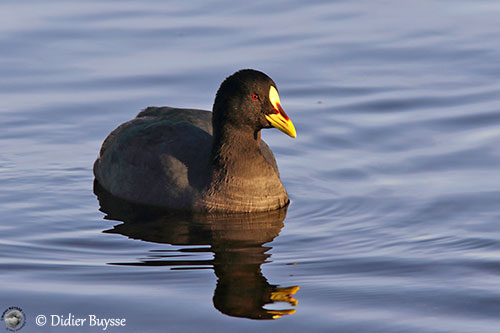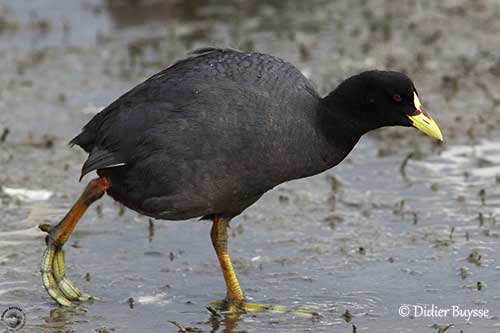
Fr: Foulque à jarretières
Ang: Red-gartered Coot
All: Gelbschnabel-Bläßhuhn
Esp: Focha de Ligas
Ita: Folaga zamperosse
Nd: Roodbandkoet
Sd: rödgulpannad sothöna
Photographers:
John Anderson
John Anderson Photo Galleries
Didier Buysse
Vision d’Oiseaux
Eduardo Andrés Jordan
MIS AVES – AVES DE ARGENTINA
Philippe and Aline Wolfer
OISEAUX D'ARGENTINE
Text by Nicole Bouglouan
Sources:
HANDBOOK OF THE BIRDS OF THE WORLD Vol 3 by Josep del Hoyo-Andrew Elliott-Jordi Sargatal - Lynx Edicions - ISBN: 8487334202
Argentine Ornithology, Volume II (of II) - A descriptive catalogue of the birds of the Argentine Republic De Philip Lutley Sclater, William Henry Hudson – Editeur: Read Books Ltd, 2016 – ISBN: 1473346606, 9781473346604 – 318 pages
Manual of Neotropical Birds, Volume 1 De Emmet Reid Blake – Editeur: University of Chicago Press, 1977 – ISBN: 0226056414, 9780226056418 – 674 pages
Wildlife Conservation Society Birds of Brazil: The Atlantic Forest of Southeast Brazil, including São Paulo and Rio de Janeiro De Robert S. Ridgely, John A. Gwynne, Guy Tudor, Martha Argel – Editeur: Cornell University Press, 2016 – ISBN: 1501704303, 9781501704307 – 432 pages
Birding Patagonia – Adventure expeditions
Arthur Grosset's Birds (Arthur Grosset)
Wikipedia, la enciclopedia libre
Red-gartered Coot
Fulica armillata
Gruiformes Order – Rallidae Family
INTRODUCTION:
The Red-gartered Coot is a large coot in the genus Fulica. It is found in the southern half of South America where it frequents ponds and lakes, rivers and streams, and marshes with or without emergent aquatic vegetation.
This good diver and swimmer feeds on pieces of marshy vegetation, but it may occasionally feed on land too. It nests in a floating structure made with reeds and other plants anchored to the bottom. Both adults share the nesting duties.
The name of this species refers to the red “garter” visible above the ankle joint.
The Red-gartered Coot is described as “common” but it is vulnerable to habitat modifications. However, it is not globally threatened.

DESCRIPTION OF THE BIRD:
Biometrics:
Length: 43-51 cm
The Red-gartered Coot has dark slaty plumage overall, blacker on head and neck. Back, scapulars, wing-coverts, uppertail-coverts and rectrices are slate-grey. On the upperwing, both primaries and secondaries are brownish-grey, and there is a thin, white margin on the outer web of the outer primary.
On the underparts, wing-coverts and axillaries are brownish-grey, whereas breast, flanks and belly are slate-grey, the latter being paler and faintly edged with whitish. The white undertail-coverts have blackish centres.
On the black head, both bill and frontal shield are pale yellow. There is a distinct red mark on the upper ridge of the culmen and at bases of both mandibles. The eyes are red to reddish. Legs and lobbed feet are orange-yellow to yellowish or olive, with a pale red “garter” above the ankle joint, giving the bird its name.
Male and female are similar.
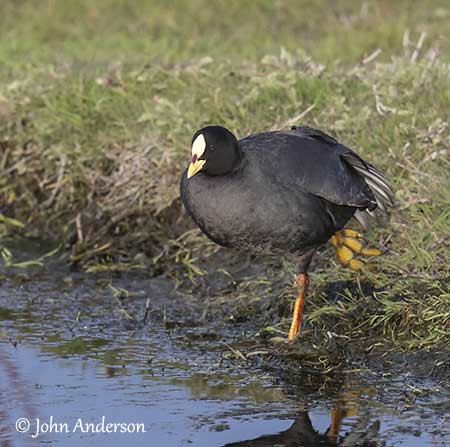
The juvenile has brownish-grey plumage on wings and upperparts, whereas underparts are pale grey with brownish wash and white speckles. Head and neck are mostly whitish with dark brown mottling on hind neck and crown. The olive-brown bill may have a yellowish tip, and the frontal shield is much reduced.
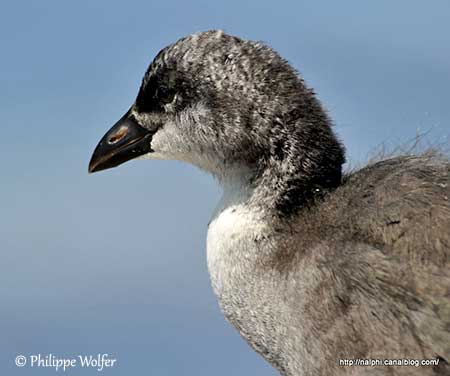
RANGE:
The Red-gartered Coot is found in C and S Chile, SE Brazil and Uruguay, S through Argentina to Tierra del Fuego.
HABITAT:
The Red-gartered Coot lives in ponds and lakes, rivers and streams, marshes and deep, clear ditches. It may forage, but rarely, on small pools and in protected waters near lakes. It frequents habitats with or without emergent aquatic vegetation.
In Patagonia, it is mainly found in lowlands, but it may reach up to 1,200 metres of elevation on barren plateaux of inland Patagonia. In S Andes, it occurs up to 1,000 metres and in NW Argentina, it breeds at 2,100 metres in Jujuy.
Large flocks usually remain in sheltered marine bays during winter.
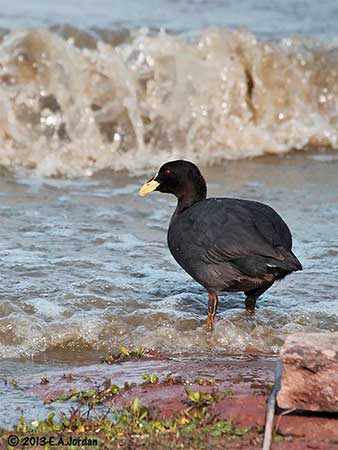
CALLS AND SONGS: SOUNDS BY XENO-CANTO
The Red-gartered Coot male utters a repeated, soft “cuit” when it is close to the female. In aggression, it gives an explosive “pit” and a repeated “wuw”.
In alarm, the male gives a short, whistled “huit” whereas the female produces a “yec” and a loud “terr” repeated several times.
BEHAVIOUR IN THE WILD:
The Red-gartered Coot feeds on water surface but it also dives. It feeds on various plant materials such as shoots, stems, leaves and seeds of aquatic plants, and also filamentous algae. It also feeds on tender grass on land.
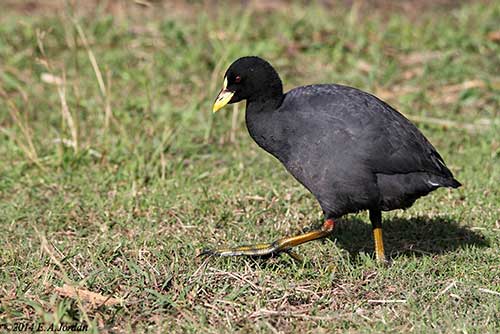
It forages mainly in open, relatively deep water. It sometimes upends like ducks. But it also forages on land near water. It is a common herbivorous species on coastal wetlands. It feeds primarily on submerged macrophyte (Stuckenia pectinata) which is very abundant in some areas in C Chile.
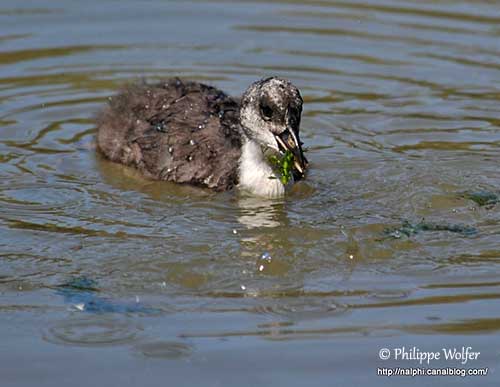
However, the Red-gartered Coot has been observed feeding on an unusual food item in Argentina, at Mar Chiquita Coastal Lagoon. The coots were catching crabs (Cyrtograpsus angulatus), and especially small ones by diving.
These birds are very good divers and swimmers.
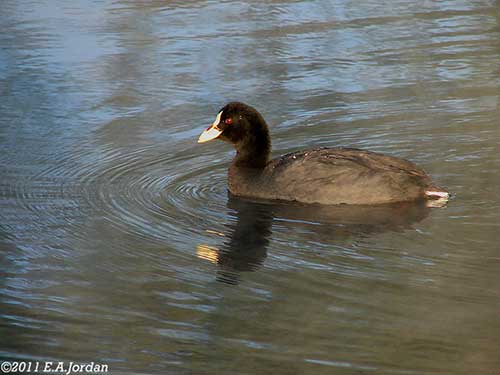
The Red-gartered Coot is gregarious and can be found in scattered groups, but also in large flocks of several hundreds, depending on the season.
They often engage in fights and disputes among them, and they are very territorial during the breeding season. They often drive away both birds of their own species and other aquatic birds.
They are monogamous and both adults share the nesting duties.
The Red-gartered Coot is usually sedentary, but they occasionally reach some islands such as Falkland Islands, South Georgia and South Sandwich Islands. Local concentrations also occur.
The Red-gartered Coot is also a good flier, but the take-off needs some pattering along water surface while beating the wings. It generally moves from one place to another at night.
If threatened, it prefers to swim, sometimes with help of strong wingbeats.
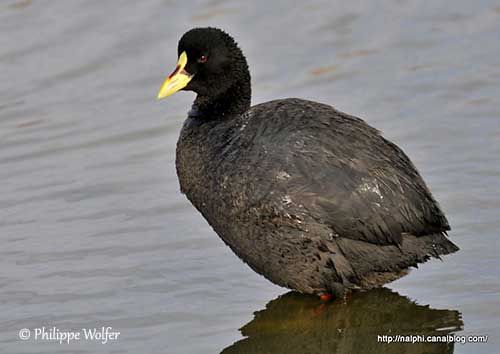
REPRODUCTION OF THIS SPECIES:
The breeding season takes place in October-November in Chile where replacement clutches may occur until January, in November in Brazil, and there are two peaks in Argentina, in mid-September and mid-October.
The Red-gartered Coot is very territorial and aggressive when breeding.
The nest is a platform made with dried, crossed reeds or rushes. It is circular with a shallow cup. It is built in pond, lagoon and other types of waters, in an area free of floating vegetation. The nest is floating or anchored to the bottom.
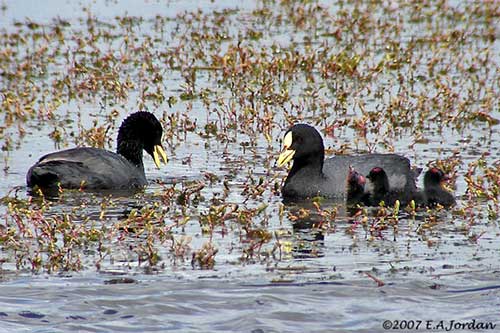
The female usually lays 7 (2-8) buff-cream or brownish eggs with darker markings. Both adults share the incubation during 24-25 days, and become very aggressive towards other coots and aquatic birds.
At hatching, the chicks are covered with black down. There is a partly naked pink or blue area on the crown. They have some orange bristles on the throat. The bill is black with orange band and the shield is red.
Both parents feed them but they are able to dive very soon.
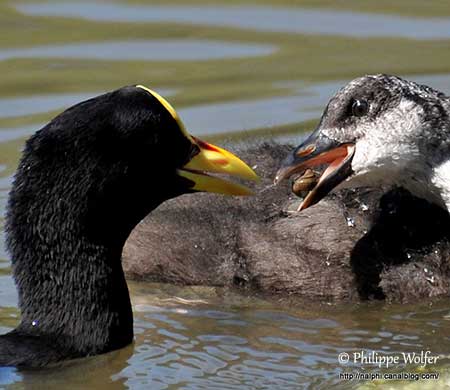
PROTECTION / THREATS / STATUS:
The Red-gartered Coot is relatively common throughout its large range. The population is roughly estimated to number 1,000,000 individuals.
The species may be affected by modification of the habitat, but it is not globally threatened and currently evaluated as Least Concern.
